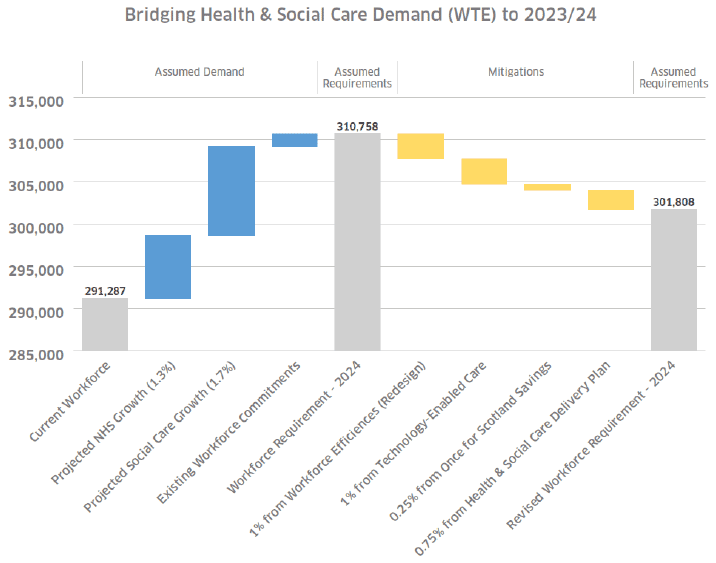Health and social care: integrated workforce plan
Sets out our future workforce requirements in a national context and provides revised workforce planning guidance to health and social care employers.
Introduction
The approach we are taking
In Scotland improving workforce planning is vital to sustaining our high quality and safe services into the future. National comparisons of healthcare workforce planning[1] have underlined the need for a range of responses to global supply and demand challenges. That is why we have focused on implementing clear methodologies, generating better quality data to help assess gaps, and building collective knowledge around workforce planning.
It is important to recognise the variance in the aims and needs for workforce planners, considering different areas of the health and social care workforce. For example, social services are commissioned from a range of providers, with the workforce employed by more than a thousand providers in the public, independent and third sectors, many of whom employ less than 50 people. The majority of social service staff achieve their qualification after they have started work in the sector, in contrast with many professional groups in health services. These differences have implications for workforce planning arrangements and needs for different parts of the system, and for the levers available to influence workforce supply.
Complex, constantly shifting dynamics around the health and social care workforce mean that difficult choices around resources and priorities will continue to arise. For example, the shift in emphasis from planning for single professions towards multi-disciplinary, team-based care needs further progress to be made on workforce data to develop the evidence base required.
The modelling assumptions in this Plan and the associated scenarios therefore range in robustness, reflecting our best assessment at this point. However they provide a base for building our collective workforce planning capabilities, and future iterations of this plan will develop these still further - for example by including improved intelligence on social care career pathways. These developments in service delivery, data quality and understanding of demand underpin the need for workforce planning to be an iterative process.
The workforce we require
Cumulatively our current health and social care workforce stands at over 368,000 headcount. This translates to 291,000 Whole Time Equivalent (WTE - calculated using the most up to date available data on the NHS workforce and Scottish Social Services Council official statistics on the social services workforce).
The Scottish Government's Medium Term Financial Framework[2] (MTFF) estimates that to address the effects of demand, we will require 1.3% per annum more NHS employees and 1.7% per annum more social care employees in the period to 2023/24.
In terms of these estimates, and to address the likely effects of health and social care demand, we estimate that Scotland will require around 20,000 WTE more health and social care employees in the period to 2023/24.
While the steps taken in successive Programmes for Government will help, growing this number of staff in response to demand is a challenging target to achieve in a comparatively short timeframe, particularly when services are subject to sustained pressure.

Assessing and addressing need and demand
As set out in the diagram above mitigating actions may help reduce this requirement by up to 10,000 WTE, by enabling redesigned workforce roles, realising technology-enabled care, and examining how we deliver services.
For technology-enabled care, for example[3], the MTFF equates technology-enabled care with a 1% saving in terms of staffing demand. The MTFF also identifies potential efficiency savings of 0.25%, accruing from regional working and other approaches set out in Once for Scotland. Recognising the need for sustained change over the longer term Scottish Government estimates that the policies to shift the balance of care and set in play in the Health and Social Care Delivery Plan[4] published in December 2016, will help to reduce the demand in the numbers of staff we need by around 0.75%.
Analysing the evidence
As Audit Scotland has observed[5] broader analysis is needed to support planning for a different type of workforce. Alongside other organisations, we recognise that wider evidence will be essential in developing national modelling and scenario planning capacity for the future. National modelling being undertaken around the Delivery Plan by ISD Scotland already includes a workforce dimension alongside service planning and financial planning elements. In addition to this NHS Education for Scotland (NES) and the Scottish Social Services Council (SSSC) are both working to develop a more comprehensive evidence base around the health and social care workforce.
This work will help workforce planners to fully understand the impact of change on our health and social care staff and service delivery, and help to forge new partnership approaches. For example, the Scottish Government is working alongside Cancer Research UK to help determine the shape of the future cancer workforce, and expects to do so with many more stakeholder groups and organisations in the coming months and years.
Successive iterations of this Plan will continue to build and sustain these collaborative links - assessing demand and providing analysis to ensure our health and care services have the right numbers of staff that people in Scotland need and deserve, well into the future.
Contact
Email: nichola.hattie@gov.scot
There is a problem
Thanks for your feedback